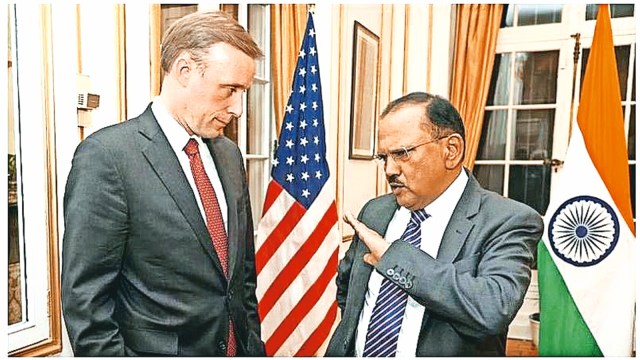When US NSA Jake Sullivan met NSA Ajit Doval in August in Jeddah on the sidelines of a meeting on the Russia-Ukraine war, it was the first time that the US administration brought up at the highest level the issue of the alleged plot to kill Khalistan separatist Gurpatwant Singh Pannun, The Indian Express has learnt.
The two NSAs were in Saudi Arabia for the meeting, which was attended by about 40 countries.

It is learnt that when Sullivan raised the issue during the meeting on August 5-6, Doval sought more information on the matter, and conveyed that the Indian government can only investigate if there are specific details about an alleged plot and not just some chatter on messaging platforms, sources said.
The NSAs, who had met once in February for the Initiative on Critical and Emerging Technologies dialogue, and again twice in June in the run-up to Prime Minister Narendra Modi’s visit to the US and during the visit, had developed a “working rapport”, but the meeting ended on a “we-will-get-back-to-you” note.
A week or so later, around India’s Independence Day, CIA Director William J Burns – a veteran US diplomat, he retired as US Deputy Secretary of State in the Obama administration – came to India and shared some initial information gathered by the US agencies, and told Indian authorities that it was still “work in progress”.
Burns met the entire top brass in the Indian establishment, including NSA Doval, R&AW chief Ravi Sinha, to convey the serious nature of the information they were gathering. The Indian side again asked them to give them more information before they could act officially on a matter so sensitive.
Sources said the Canadian National Security and Intelligence Advisor Jody Thomas also came around that time in mid-August, and also met Doval and the top brass of the intelligence agencies. Before Canadian Prime Minister Trudeau’s allegation about a potential Indian government link to the killing of Khalistan separatist Hardeep Singh Nijjar, Jody Thomas made two trips to India in August and again during the G20 summit in September.
Story continues below this ad
The Indian side, however, made a clear distinction between the US and Canada: the stance with the US was that they would look into the inputs, while they told their Canadian counterparts that if they had anything specific, they should share the information.
According to sources, the Canadians were pointing to the US investigations all along – which they were aware of because of their Five Eyes intelligence-sharing network – and they didn’t have anything of their own until then and so didn’t share anything specific.
“It was clear that they, the Americans and the Canadians, were coordinating their messages,” a source said.
So, when Trudeau stood up in the Canadian parliament and made the statement on “credible allegations”, the Indian establishment was not surprised and was prepared to respond by calling them “absurd and motivated” since they knew that the Canadians were operating on thin ice.
Story continues below this ad
But then, in October this year, US Director of National Intelligence Avril Haines came to India with concrete information that had been gathered and was going to be part of the US indictment that the federal prosecutors were preparing.
The documentation and the details in the information shared by Haines – now made public as part of the indictment filed by the US Department of Justice – made the Indian government sit up and look at the information closely. It took them a few weeks to assess the information, which had some damning evidence, and they decided to investigate.
After that, the Indian government and its officials conveyed to the US officials that they were going to investigate the information provided. And they agreed to set up the high-level probe panel on November 18 to look into all the aspects.
External Affairs Minister S Jaishankar, who had met Sullivan and US Secretary of State Antony Blinken in the US in September and had been told about the serious nature of the alleged assassination plot, conveyed to them that a high-level panel was being formed. Doval also informed Sullivan about the Indian government’s step.
Story continues below this ad
On Wednesday, Arindam Bagchi, spokesperson for the Ministry of External Affairs, said that India had constituted a high-level inquiry committee on November 18 to look into all the relevant aspects of the matter.
“We have already said that during the course of discussions with the US on bilateral security cooperation, the US side shared some inputs pertaining to nexus between organised criminals, gun runners, terrorists and others,” Bagchi said.
“We had also indicated that India takes such inputs seriously since they impinge on our national security interests as well, and relevant departments were already examining the issue,” he said.
“In this context, it is informed that on November 18, the Government of India constituted a high-level enquiry committee to look into all the relevant aspects of the matter,” he said.
Story continues below this ad
Bagchi said India will take necessary follow-up action based on the findings of the committee.









